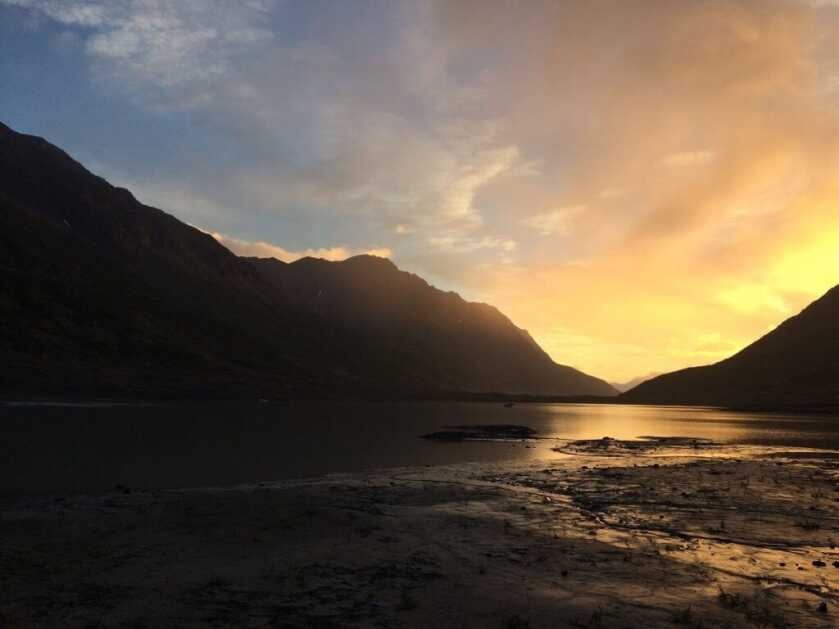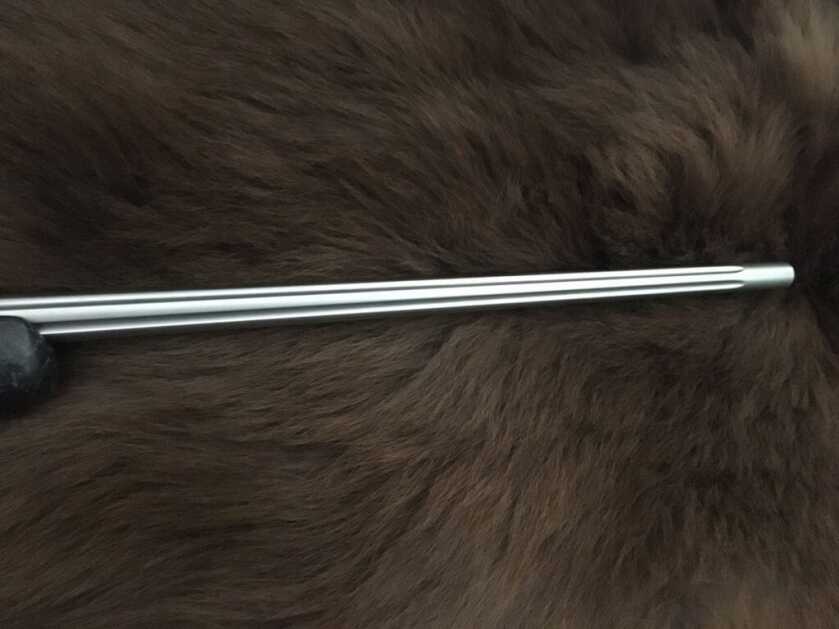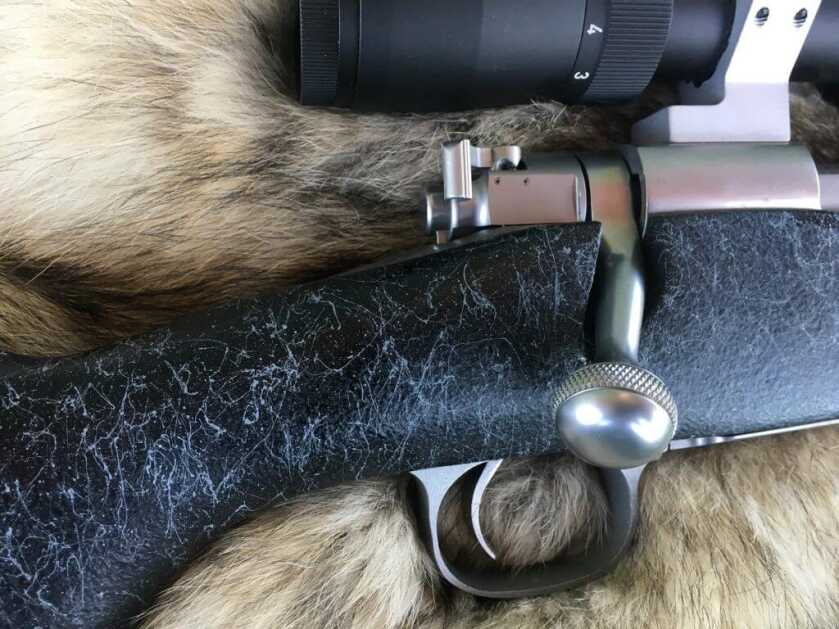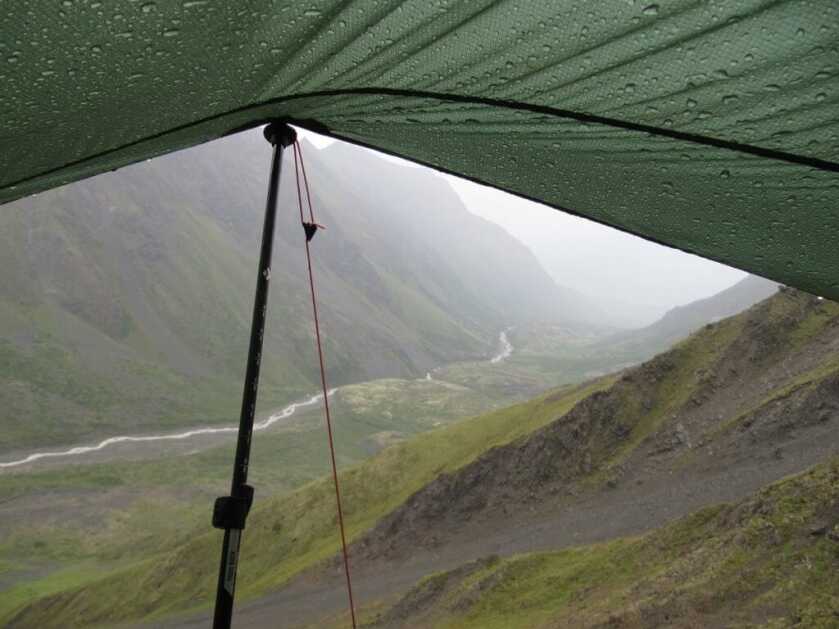
The wind came ripping off of the Bering Sea, driving a wall of rainwater ahead of it and hell-bent on blowing us off the mountain. I laid prone across a large rock, toes futilely trying to find a purchase. A caribou stood at a range a competent archer could have connected with on a calm day but this was the Aleutian Islands and those moments are few and far between. I waited until the wind dipped, removed my scope covers, and got on the trigger. At the shot, the bull fell and lay still. The water continued to cascade down while we opened the bull up and turned downhill to seek shelter at a soggy camp.
I’m the first to admit I’m a lucky man. I have a wife, two growing boys, a home and a full-time job; I also get to spend numerous weeks a year chasing Dall sheep, mountain goats, moose and brown bears in Alaska. I work for a prominent guiding outfit out of the Wasilla area with some of the best mountain hunters I’ve ever been blessed to share a camp with. We work hard, and if the clients get their animals and capes are salted and the meat’s in the freezer, we play hard- usually involving more hunting.

This year, despite my historically terrible luck at drawing tags of any kind, when the dust settled from the Alaska draw I had not one but two permits of my own. The opportunity to hunt caribou and moose for myself was exciting, to say the least, but was soon matched by a cold dose of reality. Despite the hunting opportunities I’ve had in the North Land, I’ve only ever harvested a caribou which was accomplished with my heretofore go-to rifle, a Winchester Model 70 in .270. Now, realizing the need for a step-up in caliber, I started exploring my options.
Rifle
After speaking with several well-respected people in the outdoor industry, I had a short list of ideas. Conversing with my wife and agreeing on a realistic budget, the list got even shorter. I knew I wanted a universal caliber, where the possibility of finding ammo in a pinch was realistic. After several commercial and bush flights to many areas of Alaska, there’s a very real possibility that some things can turn up missing. I also knew it had to be weather-proof, as much as possible, as there are no places I’ve hunted in the lower 48 that can match Alaska and her ferocious temperament; beating gear, men, and rifles into submission with her inclement weather.
While the list of lightweight, weatherproof rifles that won’t break the average Joe’s budget continues to grow every year, I opted for familiarity and chose a Winchester Model 70 Extreme Weather SS. The rifle came in at the advertised weight of seven pounds, four ounces naked and after mounting a scope, scope cover and sling, it tipped the scales at nine pounds even, not an ultralight sheep rifle weight but easily manageable for an all-around hunting rifle.
All major components of the rifle are stainless steel, giving the rifle it’s SS moniker. The barrel is a free-floated twenty-six-inch beauty. It’s fluted to cut weight yet maintain its stiffness and has a recessed muzzle crown to protect the rifling, according to Winchester.

The Extreme Weather comes standard with a Bell and Carlson stock that’s manufactured using their “hand lay-up process”, using several different composite materials including fiberglass, aramid fibers, epoxy gel, and laminating resin. This gives the stock a more full, dense feel than most injection molded stocks. The stock incorporates an aluminum bedding block and Pachmayr Decelerator recoil pad which, as a smaller framed guy, I appreciated. Shooting from the bench, I was surprised how long I stayed comfortable, trying numerous different weight loads and bullets.
The rifle also features the Pre ’64 claw-type extractor with controlled-round feed. This was a major selling point as knowing the very real possibility of surprising something in the brush that likes me less than my mother-in-law and, possibly having to run the bolt at awkward angles while needing a round to feed right the first time without fail was of utmost importance.

I had read about Winchester’s MOA Trigger System and was eager to see if it was everything they advertised; including no creep, over-travel, or take-up. My first day at the range, with the trigger weight set to three pounds, I settled into the rifle and started sending lead and copper downrange. It took no time at all to see that the trigger system had not been over-sold, it was crisp and clean, shot after shot.

Caliber
As most hunters who’ve had the opportunity to hunt the remote regions of Alaska know, there can be numerous unforeseen circumstances that can test patience and resolve. Gear failures, a broken pack miles from a pickup point, boots that come unsoled like a big rig truck tire on the interstate, and countless more challenges that could test Mother Theresa’s patience are not uncommon. Because of Murphy’s Law and its prevalence, I decided to get my Extreme Weather in .300 Win Mag. One of the most popular calibers for hunting the Great Land since its inception in 1963, the cartridge was released by Winchester for use in its Model 70 hunting rifle, a touch of history I found noteworthy. If something were to go wrong and I discovered myself without ammo, I would lay good money that I could get my hands on a box of .300 Win Mag before much else.
There’s no question that other .30 caliber cartridges with better performance have been introduced since the .300 Winchester Magnum but the popularity of the Win Mag is still strong and can’t be argued with. The plethora of options from ammunition manufacturers avails itself to the hunter who doesn’t have numerous hunting rifles at their disposal. A stop at a local sporting goods store can provide ammo in a variety of price points and uses, giving everyone from the recreational shooter to hardcore outdoorsman several options to choose from.

Once I had picked up the rifle from a local sporting goods store, it was time to add a scope and the various accouterments to turn it into a legitimate all-weather hunting rifle, capable of holding its own no matter what Mother Nature throws at it.
Specifications for the Winchester Model 70 Extreme Weather SS are below:
| MSRP- $1379.99 | |
| Action Length- Long Action | Caliber- 300 Win Mag |
| Barrel Length- 26″ | Overall Length- 46 3/4″ |
| Length of Pull- 13 3/4″ | Drop at Comb- 1/2″ |
| Drop at Heel- 1/2″ | Weight- 7 lbs 4 oz |
| Magazine Capacity- 3 | Twist Rate- 10″ |
| Barrel Finish- Matte | Stock Finish- Textured |
| Receiver Finish- Matte | Chamber Finish- Polished |
| Barrel Material- Stainless | Barrel Contour- Sporter |
| Stock Material- Composite | Recoil Pad- Pachmayr Decelerator |
| Pistol Grip Cap- None | Checkering- None |
| Sling Swivel Studs- Matte Nickel | Receiver Material- Stainless |
| Trigger Finish- Matte | Bolt Slide Finish- Jeweled |
| Magazine Type- Hinged Floorplate | Trigger Material- Stainless Steel |
| Trigger Guard Material- Alloy | Trigger Guard Engraving- None |
| Floor Plate Material- Stainless | Drilled and Tapped for Scope- Yes |
Watch for Part II next month.


I hunted from Eilson AFB to Galbreth Camp with a Sako .300 Win Mag. Never failed me, never needed a second shot.
I cannot find a draw hunt for caribou in the 2 units that cover the Aleutions. Why put in for a bou draw in Alaska, even as a non res., with so many places to hunt bou on an OTC tag?
Same with Moose, plenty of places to hunt moose without going for draw tags.
Looking forward to part 2.
Moved to Alaska in ’82. Lived in Kodiak, Sitka, Interior and a job that took me from Attu to Barrow (now Utqiagvik), across the North Slope and ever coastal village from Canada to Dutch Harbor. Former Alaska Hunter Safety Instructor. I hate articles like these, written by someone who came up for a single hunt or two …. but I am liking this. Well thought out choosing a cartridge that additional ammo could be found if TSA took yours is very important. I have seen hunters arrive for their dream hunt – only to discover 25-06, Weatherby or 338 Lapua was not on the local village shelves. Now they get a borrowed rifle tossed at them, an hour at the range – then off to hunt! Yikes.
What did the author miss on this article? Sling. Imagine a 3 day hunt with a noisy or uncomfortable sling, one that keeps letting loose (those push to open models) – or just doesn’t adjust well for you. In Alaska you want a Slogan rubber sling – its only down side…..you need to leave it outdoors a few months for the odor to go away, not kidding. It is still pliable at -40F.
What else was missed? Complete spare rifle. Yes. You absolutely need a spare at base camp. 4:30am my partner puts my rifle on the atv, does not bungie cord it down. She goes to move it – yup, rifle falls forward and she drives over it. I just shrug, put the 308win back in the truck, pull out the 243win and we had a nice hunt. Your group should have one spare rifle. Best if they got some trigger time on it before the big hunt.
What else was missed. Bore sighter. In the wilds of Alaska your rifle is going to take it in the shorts. I keep a culumulator version bore sighter at camp. This way when I fall, roll the atv, or bang the rifle or scope – I can not only test the scope – I can put it back where it needs to be. Your rifle is going to get dings and scrapes in Alaska. If you cant bring a spare rifle – you bring a bore sighter. Since you will be in a party of 2-5, only one person need have it.
These are not armchair rants. These are ‘lessons learned’ from botch hunts, missed shots, poor planning with new hunters I have taken out. I graduated from two military survival schools. I know how to ‘make do’ – and I can tell you, ‘making do’ is no fun. Your hunt should not be like a day at work.
As to the model 70 choice -awesome rifle – but -they don’t fit me well. In the store, pick a point and bring it up to that point – the sights should instantly be on it. If you have to schooch your head left, right, up or down – its not for you. Grab a different make or model – try again. I see lots of hunters with rifles that don’t fit them. 4 hrs at the range to finally get a decent group. Next morning the first shot is crap – and 4 more hours wearing down the adjustment knobs for nothing. If your head need be in a specific sweet spot…. probably not the rifle for you. Rifles are like shoes – you buy what fits. You play Cinderella and get trigger time on all your friends rifles before deciding on a make and model. Fact is nobody in America makes a bad bolt action stainless rifle – you just need to find what fits. Lucky you if its an affordable model. If only and expensive model fits, and you are married – well – then you will understand why I am on wife version 3.0
Great article. If I won a tag and had never been to Alaska – I would memorize this guys writings. Its solid gold.
Well written & thoughtful article. Agree with all the points. Made me think of my Tikka T3’s in 270 WSM, 300 WSM & 300 WM. Similar characteristics – easy to carry due to light weight, great stock design to deal with recoil, absolutely wonderful triggers, and super accurate – typically .5″ to .6″ is typical “out of the box” performance with “run of the mill” ammo.
What’s not to like or more to ask for without breaking the bank!
Much older, but similar Model 70s chambered and barrelled in .25/06, .30/06. and .338/06. Never reached out further than I could hunt. Never needed more. Still fired regularly. Wonderful companions, each a reliable meat-getter.